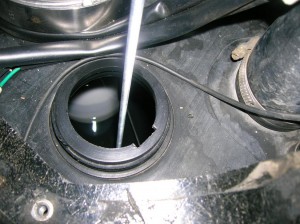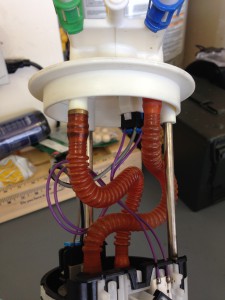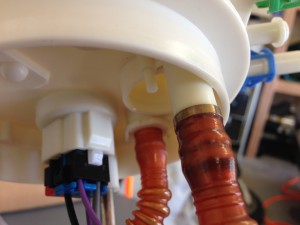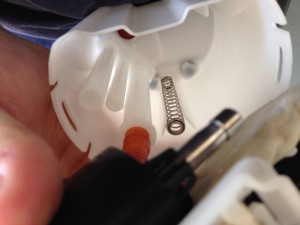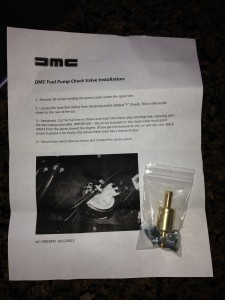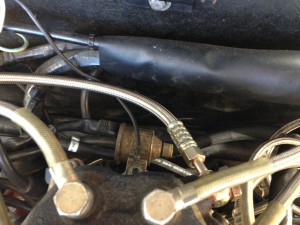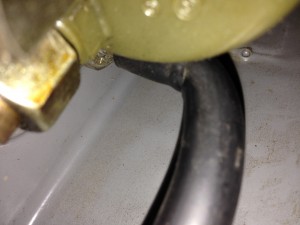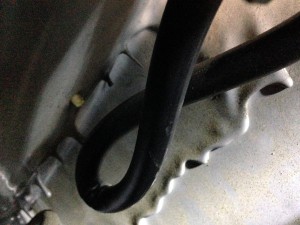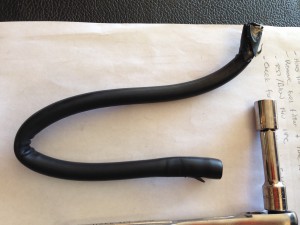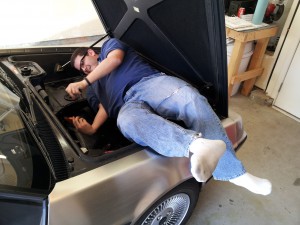So back in June I posted about my install of the brand new and upgraded fuel pump and level sender combo unit from DMCH. This was a significant (and expensive) upgrade to the car, as it eliminates the complicated pickup baffle system and failure/inaccuracy prone level sender to power the fuel gauge. But, as it turned out, this pump was not without design problems of its own. Many users (including local owner Ryan) reported that the pump was unable to hold rest pressure and was introducing hot start issues where none previously existed. While I was not seeing this behavior myself, I did notice that the car seemed to suffer from sputtering and loss of power under load when the tank was low – 1/4 full or less. The symptoms were the same as those of a collapsed pickup hose in the OEM configuration – one of the exact problems I was trying to eliminate by upgrading the pump.
Another owner on DMCTalk suggested that since the lower portion of the pump is spring-loaded to ensure it rests on the bottom of the tank, perhaps it had compressed and gotten stuck during installation. This would lead to the last dregs of fuel being unable to be sucked up and would easily account for the problems I was seeing. Due to my busy schedule, it took me a few months to run the fuel tank low enough to do a proper inspection – but I was finally able to a few weeks ago. I was not surprised but a little discouraged to find that the installation was correct – something else must be going on.
First I checked to see if the float for the sender was just caught somehow – maybe I’m actually out of fuel and just don’t know it? To do that, I held the float down with a rod and checked the gauge.
Nope, no problem there….
Deciding to take a chance, I had Colleen start the car while I observed the pump operation through the blanked-off OEM sender hole. Here’s what I saw.
Uh oh. That’s almost certainly not supposed to happen…. Taking a closer look, it became clear that the fuel was spraying out of the top of the pump itself. Why is that happening?
To really analyze the part, I had no choice but to remove it from the car. After inspection, it didn’t seem that the unit was physically damaged or defective in any way, and the whole thing was as clean as could be:
So what the hell? I called Dave at DMC Midwest and described my symptoms. Once he watched the videos above, he agreed that something was clearly not right and that he needed to get his hands on the pump for testing. So off it went to Crystal Lake. After a few days, he called me back – he couldn’t replicate what I was seeing, and there was nothing obviously wrong with the unit. But the videos and evidence I had were undeniable, and he generously replaced the whole pump for me.
A week later…
A brand new assembly arrived, complete with an inline check valve meant to eliminate the hot start problems that other owners like Ryan had observed. Great! I set about installing the new assembly and check valve – I messed the latter up, installing it in the return line rather than the feed line. Luckily I caught my mistake immediately and was able to swap the lines around to fix it.
Here’s the check valve installed and ready to go.
So, now I was really excited to get my car back on the road and go enjoy the nice weather. Video camera in hand, we fired up the engine and….
F@$$#(@$#(@*%*@(!!!!!! What is causing this???
After trading a dozen more emails and phone calls with DMCMW, Dave agreed that the problem must be environmental to my car and that we needed to do some live troubleshooting. He agreed to spend his Saturday on a videoconference with me while some tests were carried out – nice guy, huh? Clint and David joined me for the event and we got to work.
The first thing we tried was inspecting the lines at the fuel distributor – any kinks or twists?
Nope, looks good. Next test was to disconnect the feed line and run the pump into a bucket.
Unhooked this line, and did this with it:
Plenty of fuel there, so there’s no blockage. So we’re no closer yet.
We did notice that with the engine off (fuel pump just jumpered in the wiring harness to run all the time) there was much less pressure behind the leak.
That was confusing, since the pump should be providing the same pressure regardless. So that led us to conclude that the issue was worsening under load. That made a little sense, since the symptoms of power loss and hesitation really only occurred under acceleration or high speed highway cruising. As you can see in the videos below, the motor fires right up and runs just fine at idle, even with the leaking pump.
Hooking up a set of K-Jet pressure gauges we borrowed from Ryan, we tested the control pressure and vacuum to the regulator. Everything was dead on. The accumulator also held rest pressure for an extraordinarily long time (a very good thing) – so there’s no major systemic failures.
Dave was stumped, and so were we. The lines were all new. The filter was new. Pump was new. Injectors were recently cleaned. He agreed to think it over some more and we ended our video chat.
About an hour later he called back with an idea – every fuel line was brand new, but did I do the ones no one ever thinks of? There are two short lengths of flexible line that connect the accumulator at the center of the frame to the sections of hard line running from end to end of the car. No – I had purchased replacement parts, but due to the difficulty of installing them, I hadn’t gotten to it yet. Dave suggested we inspect those lines for kinks or breaks. Here’s what we found:
That almost certainly isn’t good. These old style fuel hoses are a three-layer design: a thin rubber outer sheath around a protective woven layer, covering a nylon (or Teflon) core line. The core section is stiff – and in this chunk of line, it had bent into a pretty severe kink and stuck that way. This was a serious “well, there’s your problem” moment for us.
Cutting the line out, we could see the full extent of the kink:
It makes total sense that this was allowing enough fuel to flow at idle, but starving the motor completely when the demand increased. So with Clint’s help (and power of super skinniness) the old line was cut out and a brand new one installed in only about 20 minutes. It was sheer luck that I had exactly the parts we needed sitting on the shelf. He also tightened up a shift pivot bolt that was a little loose – that tiny cubby in the frame is one place I couldn’t reach to do this kind of stuff myself.
Excited that we might have finally solved it, I climbed into the trunk to take one last video…
And here’s what we saw!
Success! What you see above is the exact expected behavior of the pump. It should run quietly and without leaks, the baffle should fill up almost immediately and keep overflowing constantly until the pump shuts off or every drop of fuel is exhausted. It seems that the kinked hose was causing a backpressure condition that was in turn causing a pressure relief valve at the top of the pump to open and spray fuel everywhere.
After that, it was time for a road test – and what a difference it made. Not only did the sputtering and power loss disappear, but the car overall had more pep and the shifts were even more precise thanks to the re-torqued pivot bolt. Amazing.
Thanks for reading this far and thanks to Clint, David, Ryan and especially DMCMW for helping with this!
